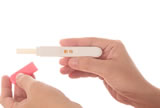How to check your cervical position
| on 19th February 2013 |
Checking your cervical position may sound like something that only a doctor or nurse would be taught how to do, but it is something that you can teach yourself. You may be wondering why you would ever want to know what your cervical position is. The position of your cervix is one way to tell whether or not you are ovulating, and it is also just really neat to know your body that well.

You may already know that the consistency of your cervical mucus changes around the time of ovulation. What you may not have known is that the position of your cervix also changes at different times of the month. Cervical mucus can also be difficult to distinguish from sperm. Sperm can stay in your cervix for up to three days after intercourse so knowing your cervical position can be very helpful in determining when ovulation will occur. Determining your cervical position is not very difficult and will only take you a few minutes every couple of days. Below you will find step by step instructions for how to determine your cervical position.
1. Wash your hands very, very well. You do not want to introduce germs or infection to your reproductive system. If you have a yeast infection or any other type of reproductive system infection you will need to wait until it has completely cleared up before checking your cervical position.
2. Find a comfortable position where you can easily reach your cervix. This will be different for each woman. Some women sit on the toilet, some women squat, and some women like to put one leg up on the edge of the bed or the bathtub.
3. Some women like to think of their vagina has a hallway and consider the cervix to be the door at the opposite end of the hall. Your vagina has a spongy soft feel to it and gives way easily to pressure. Your cervix feels like a firm, round dimple that feels like the tip of your nose when you are not fertile. When you are approaching your fertile time of the month your cervix feels more like your lips. What you are looking for is for your cervix to feel full and soft like your lips.
4. Take your index or middle finger and slowly insert it into your vagina. Slide your finger in as far as you can reach in an upward and in motion. As long as you are not nearing ovulation your cervix should be easy to reach. If you are currently ovulating you may be unable to reach your cervix because it moves higher up into your body.
When you are just beginning to learn how to find your cervical position, it is important to check it every few days, especially when you are not ovulating. Finding your cervical position is much easier when you are not ovulating.
5. As you get closer to ovulation your cervix moves up higher and higher. Your cervix will become softer and more open . If you are trying to get pregnant then you should definitely make time for sex when your cervix is high, soft, and open. If your cervix is closed, low, and firm then you are probably not nearing ovulation yet. After you get used to checking your cervix telling when you are fertile is really easy, but it does take time.
6. Understanding your body can make you feel very empowered. Some women feel that touching their body this way is violating some kind of code or something, or that only doctors should examine that area of their body. There is absolutely nothing wrong with exploring your body or trying to become more in tune with your cycles. Particularly for women trying to conceive, this technique can be very helpful. Just be gentle and you should have nothing to worry about. You should also make sure that your nails are filed smooth so that you don't have to worry about scratches. If you still have concerns you should discuss the benefits of checking your cervical position with your gynecologist.
7. Marking your cervical position on a fertility chart can help you to track the ovulation portion of your cycle. Most fertility charts will ask if your cervix feels high, medium or low, and if it feels firm, medium, or soft. They may also ask if your cervix feels open or closed.
8. Don't expect to get this right on the first try. Being able to evaluate your cervical position will only come with practice. Some women have to go through several monthly cycles before they are able to accurately evaluate their cervical position.
Things to keep in mind:
For some women, especially those who have not given birth, their cervix may always feel slightly open. Even if your cervix always feels slightly open you should still be able to monitor cervical position by the softness and height of it. This may also be true of women who have had miscarriages, and those who have not delivered a child vaginally.
As ovulation nears your cervix will be higher (you may not even be able to reach it), softer, and more open. There will also be more cervical mucus near the cervix when ovulation is close. You may also choose to check your cervical mucus while you are checking the position of your cervix. Many women who are trying to conceive also check their cervical mucus so that they know when ovulation is near.
You should not check your cervix during or after intercourse. Your cervix actually moves around based on the level of your arousal no matter when you will ovulate.
Try to check your cervical position around the same time each day. Many women like to check their cervical position in the morning after they shower because they are already clean and undressed.
Some women are under the impression that they can tell if they are pregnant by checking their cervical position. Unfortunately, this is not true. Your cervical position won't feel different enough even if you have conceived for you to be able to determine that. You will still have to wait for the pregnancy test results to know for sure that you have conceived.
Video Source: Youtube
Copyright © 2012 Babiesbase.and respective owners. All rights reserved.
Other product and company names shown may be trademarks of their respective owners.











 Sign up for our week by week
Sign up for our week by week
